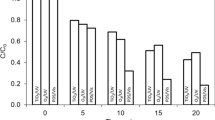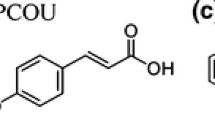Abstract
Wastewater from textile manufacturing introduces recalcitrant organic compounds, such as dyes and toxic by-products into the environment, where advanced oxidation processes are used to treat toxic and non-biodegradable organic pollutants which cannot be removed by traditional methods. H2O2/UV, photo-Fenton and heterogeneous photocatalysis (TiO2/H2O2/UV) processes were used, and the effect of the hydraulic retention time on total organic carbon (TOC) removal was evaluated by fitting the analytical data for the three processes to different kinetic models. The high correlation between empirical and modelled data was accomplished with a pseudo-first-order model for the three processes (R 2 = 0.9823 ± 0.017). Mineralisation, decolourisation and disinfection of textile wastewater were investigated with laboratory-scale experiments for each process. Data showed that when 5 g/L H2O2 was used, heterogeneous photocatalysis was the most effective method for the removal of TOC (94.55 %). With respect to colour, all three processes achieved nearly 100 % removal (99.6, 99.3 and 99.9 % at 120 min for the H2O2/UV, photo-Fenton and TiO2/H2O2/UV processes, respectively).



Similar content being viewed by others
References
Agustina TE, Ang HM, Vareek VK (2005) A review of synergistic effect of photocatalysis and ozonation on wastewater treatment. J Photochem Photobiol C 6:264–273
Alaton IA, Balcioglu IA, Bahnemann DW (2002) Advanced oxidation of a reactive dyebath effluent: comparison of O3, H2O2/UV-C and TiO2/UV-A processes. Water Res 36:1143–1154
Aleboyeh A, Moussa Y, Aleboyeh H (2005) The effect of operational parameters on UV/H2O2 decolourisation of Acid Blue 74. Dyes Pigments 66:129–134
APHA (2012) Standard methods for the examination of water and wastewater, 20th edn. American Public Health Association, Washington DC
Arslan I, Balcioglu IA, Bahnemann DW (2000) Advanced chemical oxidation of reactive dyes in simulated dyehouse effluents by ferrioxalate-Fenton/UV-A and TiO2/UV-A processes. Dyes Pigments 47:207–218
Arslan-Alaton I, Tureli G, Olmez-Hanci T (2009) Treatment of azo dye production wastewaters using photo-Fenton-like advanced oxidation processes: optimization by response surface methodology. J Photochem Photobiol A 202:142–153
Bali U, Çatalkayab E, Sengül F (2004) Photodegradation of Reactive Black 5, Direct Red 28 and Direct Yellow 12 using UV, UV/H2O2 and UV/H2O2/Fe2+: a comparative study. J Hazard Mater B114:159–166
Blanco J, Torrades F, De la Varga M, García-Montaño J (2012) Fenton and biological-Fenton coupled processes for textile wastewater treatment and reuse. Desalination 286:394–399
Calero M, Blázquez G, Martín-Lara MA (2011) Kinetic modelling of the biosorption of lead (II) from aqueous solutions by solid waste resulting from the olive oil production. Chem Eng Data 56:3053–3060
Cao W, Mehrvar M (2011) Slaughterhouse wastewater treatment by combined anaerobic baffled reactor and UV/H2O2 processes. Chem Eng Res Des 89:1136–1143
Choi J, Jeong J-H, Chung J (2013) Degradation of acetone and isopropylalcohol in electronic wastewater using Fe- and Al-immobilized catalysts. Chem Eng J 218:260–266
Crittenden JC, Hu S, Hand DW, Green SA (1999) A kinetic model for H2O2/UV process in a completely mixed batch reactor. Water Res 33(10):2315–2328
Del Moro G, Mancini A, Mascolo G, Di Iaconi C (2013) Comparison of UV/H2O2 based AOP as an end treatment or integrated with biological degradation for treating landfill leachates. Chem Eng J 218:133–137
Elmorsi TM, Riyad YM, Mohamed ZH, Abd El Bary HMH (2010) Decolorization of Mordant red 73 azo dye in water using H2O2/UV and photo-Fenton treatment. J Hazard Mater 174:352–358
Fatta-Kassinos D, Vasquez MI, Kümmerer K (2011) Review: transformation products of pharmaceuticals in surface waters and wastewater formed during photolysis and advanced oxidation processes–degradation, elucidation of by products and assessment of their biological potency. Chemosphere 85:693–709
Garcia JC, Simionato JI, Carli da Silva AE, Nozaki J, de Souza Solar NE (2009) Photocatalytic degradation of real textile effluents by associated titanium dioxide and hydrogen peroxide. Sol Energy 83:316–322
Guo M, Hua H, Bolton JR, El-Din MG (2009) Comparison of low- and medium-pressure ultraviolet lamps: photoreactivation of Escherichia coli and total coliforms in secondary effluents of municipal wastewater treatment plants. Water Res 43:815–821
Herrmann J-M (1999) Heterogeneous photocatalysis: fundamentals and applications to the removal of various types of aqueous pollutants. Catal Today 53:115–129
Ho YS, Ng JCY, Mckay G (2000) Kinetics of pollutant sorption by biosorbents: review. Sep Purif Method 29(2):189–232
Homem V, Santos L (2011) Degradation and removal methods of antibiotics from aqueous matrices-A review. J Environ Manage 92:2304–2347
Kang S-F, Liao C-H, Po S-T (2000) Decolorization of textile wastewater by photo-Fenton oxidationtechnology. Chemosphere 41:1287–1294
Karci A, Arslan-Alaton I, Olmez-Hanci T, Bekbolet M (2012) Transformation of 2,4-dichlorophenol by H2O2/UV-C, Fenton and photo-Fenton processes: oxidation products and toxicity evolution. J Photochem Photobiol A 230:65–73
Kusic H, Koprivanac N, Horvat S, Bakija S, Bozi AL (2009) Modelling dye degradation kinetic using dark- and photo-Fenton type processes. Chem Eng J 155:144–154
Lan BY, Nigmatullin R, Puma GL (2008) Ozonation kinetics of cork-processing water in a bubble column reactor. Water Res 42:2473–2482
Ledakowicz S, Gonera M (1999) Optimisation of oxidants dose for combined chemical and biological treatment of textile wastewater. Water Res 33(11):2511–2516
Lee S-M, Kim Y-G, Cho I-H (2007) Treatment of dyeing wastewater by TiO2/H2O2/UV Process: experimental design approach for evaluating total organic carbon (TOC) removal efficiency. J Environ Sci Health A 40(2):423–436
López-López C, Martín-Pascual J, Martínez-Toledo MV, González-López J, Hontoria E, Poyatos JM (2013) Effect of the operative variables on the treatment of wastewater polluted with Phthalo Blue by H2O2/UV process. Water Air Soil Pollut 224:1725
Lucas MS, Peres JA (2006) Decolorization of the azo dye Reactive Black 5 by Fenton and photo-Fenton oxidation. Dyes Pigments 71:236–244
Lucas MS, Mosteo R, Maldonado MI, Malato S, Peres JA (2009) Solar photochemical treatment of winery wastewater in a CPC reactor. J Agric Food Chem 57:11242–11248
Maldonado MI, Passarinho PC, Oller I, Gernjak W, Fernandez P, Blanco J, Malato (2007) Photocatalytic degradation of EU priority substances: a comparison between TiO2 and Fenton plus photo-Fenton in a solar pilot plant. J Photchem Photobiol A 185(2–3):354–363
Mantzavinos D, Psillakis E (2004) Review: enhancement of biodegradability of industrial wastewaters by chemical oxidation pre-treatment. J Chem Technol Biotechnol 79:431–454
Modirshahla N, Behnajady MA, Ghanbary F (2007) Decolorization and mineralization of C.I. Acid Yellow 23 by Fenton and photo-Fenton processes. Dyes Pigments 73:305–310
Moreira R, Sauer TP, Casaril L, Humeres L (2005) Mass transfer and photocatalytic degradation of Leather dye using TiO2/UV. J Appl Electrochem 35:821–829
Pekakis PA, Xekoukoulotakis NP, Mantzavinos D (2006) Treatment of textile dyehouse wastewater by TiO2 photocatalysis. Water Res 40:1276–1286
Pitkänen T, Paakkari P, Miettinen IT, Heinonen-Tanski H, Paulin L, Hänninen M-L (2007) Comparison of media for enumeration of coliform bacteria and Escherichia coli in non-disinfected water. J Microbiol Methods 68:522–529
Poyatos JM, Muñio MM, Almecija MC, Torres JC, Hontoria E, Osorio F (2010) Advanced oxidation processes for wastewater treatment: state of the art. Water Air Soil Pollut 205:187–204
Prato-Garcia D, Buitrón G (2013) Improvement of the robustness of solar photo-Fenton processes using chemometric techniques for the decolorization of azo dye mixtures. J Environ Manage 131:66–73
Riga A, Soutsas K, Ntampegliotisa K, Karayannisa V, Papapolymerou G (2007) Effect of system parameters and of inorganic salts on the decolorization and degradation of Procion H-exl dyes. Comparison of H2O2/UV, Fenton, UV/Fenton, TiO2/UV and TiO2/UV/H2O2 processes. Desalination 211:72–86
Rubio D, Nebot E, Casanueva JF, Pulgarin C (2013) Comparative effect of simulated solar light, UV, UV/H2O2 and photo-Fenton treatment (UV–Vis/H2O2/Fe2+,3+) in the Escherichia coli inactivation in artificial seawater. Water Res 47:6367–6379
Sakkas VA, Calza P, Medana C, Villioti AE, Baiocchi C, Pelizzetti E, Albanis T (2009) Semiconductor mediated photocatalytic transformation study of the pharmaceutical agent salbutamol using TiO2 suspensions. In: Proceedings of the 11th International Conference on Environmental Science and Technology A. pp 1232–1238
Santos A, Ystos P, Rodríguez S, Romero A (2010) Mineralisation lumping kinetic model for abatement of organic pollutants using Fenton’s reagent. Catal Today 151:89–93
Schrank SG, Ribeiro dos Santos JN, Santos Souza D, Santos Souza EE (2007) Decolourisation effects of Vat Green 01 textile dye and textile wastewater using H2O2/UV process. J Photochem Photobiol A 186:125–129
Sillanpää MET, Kurniawan TA, Lo W-H (2011) Review: degradation of chelating agents in aqueous solution using advanced oxidation process (AOP). Chemosphere 83:1443–1460
Sivakumar S, Selvaraj A, Ramasamy AK, Balasubramanian V (2013) Enhanced photocatalytic degradation of reactive dyes over FeTiO3/TiO2 heterojunction in the presence of H2O2. Water Air Soil Pollut 224:1529
Taylor RW, Hassan K, Mehadi AA, Shuford JW (1995) Kinetics of zinc sorption by soils. Commun Soil Sci Plan 20(11–12):1764–1771
Verma AK, Dash DD, Bhunia P (2012) A review on chemical coagulation/flocculation technologies for removal of color from textile wastewaters. J Environ Manage 93:154–168
Weisburger JH (2002) Comments on the history and importance of aromatic and heterocyclic amines in public health. Mutat Res 506–507:9–20
Zuorro A, Fidaleo M, Lavecchia R (2013) Response surface methodology (RSM) analysis of photodegradation of sulfonated diazo dye Reactive Green 19 by UV/H2O2 process. J Environ Manage 127:28–35
Acknowledgments
This research was supported by the Spanish Ministry of Science and Technology under project reference CTM2009-11929-C02-01, and by the University of Granada through a personal research contract to J. Martín-Pascual and C. Lopez-Lopez.
Author information
Authors and Affiliations
Corresponding author
Rights and permissions
About this article
Cite this article
Lopez-Lopez, C., Martín-Pascual, J., Martínez-Toledo, M.V. et al. Kinetic modelling of TOC removal by H2O2/UV, photo-Fenton and heterogeneous photocatalysis processes to treat dye-containing wastewater. Int. J. Environ. Sci. Technol. 12, 3255–3262 (2015). https://doi.org/10.1007/s13762-015-0755-8
Received:
Revised:
Accepted:
Published:
Issue Date:
DOI: https://doi.org/10.1007/s13762-015-0755-8




